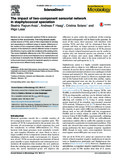Mostrar el registro sencillo del ítem
The impact of two-component sensorial network in staphylococcal speciation
| dc.creator | Rapún Araiz, Beatriz | es_ES |
| dc.creator | Haag, Andreas F. | es_ES |
| dc.creator | Solano Goñi, Cristina | es_ES |
| dc.creator | Lasa Uzcudun, Íñigo | es_ES |
| dc.date.accessioned | 2021-01-20T09:41:16Z | |
| dc.date.available | 2021-01-20T09:41:16Z | |
| dc.date.issued | 2020 | |
| dc.identifier.issn | 1369-5274 (Electronic) | |
| dc.identifier.uri | https://hdl.handle.net/2454/39034 | |
| dc.description.abstract | Bacteria use two-component systems (TCSs) to sense and respond to their environments. Free-living bacteria usually contain dozens of TCSs, each of them responsible for sensing and responding to a different range of signals. Differences in the content of two-component systems are related with the capacity of the bacteria to colonize different niches or improve the efficiency to grow under the conditions of the existing niche. This review highlights differences in the TCS content between Staphylococcus aureus and Staphylococcus saprophyticus as a case study to exemplify how the ability to sense and respond to the environment is relevant for bacterial capacity to colonize and survive in/on different body surfaces. | en |
| dc.description.sponsorship | B.R is recipient of a PhD grant from Universidad Pública de Navarra. Work in the Laboratory of Microbial Pathogenesis is funded by the Spanish Ministry of Science, Innovation and Universities grant BIO2017-83035-R Agencia Española de Investigación/Fondo Europeo de Desarrollo Regional, European Union. A.F.H. is supported by the European Research Council ERC under the European Union's Horizon 2020 research and innovation program Grant Agreement ERC-ADG-2014 Proposal no 670932 Dut-signal from EU awarded to José R. Penadés and was the recipient of a Tenovus Project Grant (S16-12). | en |
| dc.description.sponsorship | B.R is recipient of a PhD grant from Universidad Publica de Navarra. Work in the Laboratory of Microbial Pathogenesis is funded by the Spanish Ministry of Science, Innovation and Universities grant BIO2017-83035-R Agencia Espanola de Investigacio'n/Fondo Europeo de Desarrollo Regional, European Union. A.F.H. is supported by the European Research Council ERC under the European Union's Horizon 2020 research and innovation program Grant Agreement ERC-ADG-2014 Proposal no 670932 Dut-signal from EU awarded to Jose R. Penades) and was the recipient of a Tenovus Project Grant (S16-12). | en |
| dc.format.extent | 8 p. | |
| dc.format.mimetype | application/pdf | en |
| dc.language.iso | eng | en |
| dc.publisher | Elsevier | en |
| dc.relation.ispartof | Current Opinion in Microbiology, 2020, 55, 40-47 | en |
| dc.rights | © 2020 The Author(s). Published by Elsevier Ltd. This is an open access article under the CC BY-NC-ND license. | en |
| dc.rights.uri | http://creativecommons.org/licenses/by-nc-nd/4.0/ | |
| dc.subject | Staphylococcus aureus | en |
| dc.subject | Staphylococcus saprophyticus | en |
| dc.subject | Bacterias | en |
| dc.title | The impact of two-component sensorial network in staphylococcal speciation | en |
| dc.type | info:eu-repo/semantics/article | en |
| dc.type | Artículo / Artikulua | es |
| dc.contributor.department | Ciencias de la Salud | es_ES |
| dc.contributor.department | Osasun Zientziak | eu |
| dc.rights.accessRights | info:eu-repo/semantics/openAccess | en |
| dc.rights.accessRights | Acceso abierto / Sarbide irekia | es |
| dc.identifier.doi | 10.1016/j.mib.2020.02.004 | |
| dc.relation.projectID | info:eu-repo/grantAgreement/AEI/Plan Estatal de Investigación Científica y Técnica y de Innovación 2013-2016/BIO2017-83035-R/ES/ | en |
| dc.relation.projectID | info:eu-repo/grantAgreement/European Commission/Horizon 2020 Framework Programme/670932 | en |
| dc.relation.publisherversion | https://doi.org/10.1016/j.mib.2020.02.004 | |
| dc.type.version | info:eu-repo/semantics/publishedVersion | en |
| dc.type.version | Versión publicada / Argitaratu den bertsioa | es |



